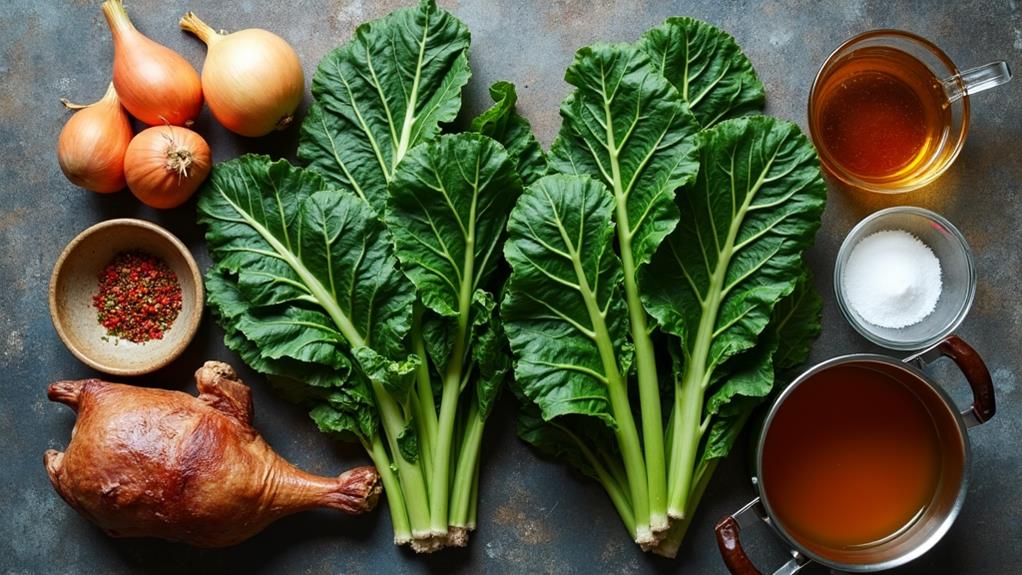When you think of collard greens, you might picture a hearty side dish steeped in tradition, but their story runs much deeper. These leafy greens not only provide a wealth of nutrients but also carry a historical significance that ties them to resilience and cultural heritage. As you explore their origins and culinary uses, you'll uncover the ways collards have shaped Southern cuisine and community celebrations. What's even more intriguing is how they've evolved in modern kitchens, blending tradition with innovation. You might find yourself wondering how to incorporate this versatile vegetable into your own meals.
Key Takeaways
- Collard greens originated from enslaved Africans and became a staple in Southern cuisine, symbolizing resilience and survival.
- They are nutrient-dense, rich in vitamins A, C, and K, and promote heart health while being low in calories.
- A traditional recipe includes fresh collard greens, smoked ham hock, and simmering for 2 to 3 hours for tenderness.
- Collard greens are culturally significant in African American traditions, often enjoyed with smoked meats and associated with good luck on New Year's Day.
- Cooking tips include cleaning thoroughly, sautéing onions for added flavor, and exploring variations like adding beans or coconut milk.
History
Exploring the history of collard greens reveals their deep roots in American culture. These leafy greens were brought to America through the transatlantic slave trade, where enslaved Africans began cultivating them in their gardens.
Over time, collard greens became a staple vegetable in Southern cuisine, particularly during the fall and winter months. They symbolize resilience and survival, as they provided essential nutrition for those who faced harsh conditions.
In kitchen gardens, collards supplemented meager rations, proving crucial during slavery. One of the most cherished ways to enjoy collards is cooked in pot likker, a flavorful broth that captures the essence of African American culinary traditions.
Eating collard greens on New Year's Day is believed to bring good luck, making them even more significant in cultural celebrations.
Today, collard greens are celebrated not just in the South but across the country. Their nutritional profile shines, packed with vitamins A, C, and K, earning them the title of superfood.
Recipe

Collard Greens Recipe
Collard greens are a staple in Southern cuisine, known for their hearty texture and rich flavor. Cooking collard greens low and slow allows the greens to become tender while absorbing the flavors from the accompanying ingredients. Traditionally, smoked ham hock or turkey is added for a savory depth, while apple cider vinegar provides a tangy contrast that enhances the dish's overall flavor profile. This recipe serves approximately 8 people, making it perfect for gatherings or meal prep throughout the week.
To guarantee the best results, start by selecting fresh, vibrant collard greens. Thoroughly clean them to remove any grit, and take the time to remove the tough stems before chopping the leaves into manageable pieces. The addition of granulated sugar balances the bitterness of the greens, while the simmering process creates a delicious pot likker that can be enjoyed alongside the greens or used in other dishes.
Ingredients:
- 2 large bunches of fresh collard greens
- 1 smoked ham hock or turkey leg (optional for a vegan version)
- 1 medium onion, chopped
- 2 tablespoons granulated sugar
- ¼ cup apple cider vinegar
- 6 cups vegetable or chicken stock
- Salt and pepper to taste
- Crushed red pepper flakes or jalapeños (optional for heat)
Cooking Instructions:
In a large pot, combine the chopped collard greens, smoked ham hock or turkey (if using), chopped onion, granulated sugar, apple cider vinegar, and stock.
Bring the mixture to a boil, then reduce the heat to low. Cover the pot and let it simmer for about 2 to 3 hours, stirring occasionally, until the greens are tender and flavorful.
Season with salt and pepper to taste before serving.
Extra Tips:
Make sure to clean the collard greens thoroughly, as any residual dirt can affect the final dish.
If you're looking to add more flavor, consider sautéing the onions in a bit of oil before adding them to the pot.
For a spicier kick, don't hesitate to incorporate crushed red pepper flakes or jalapeños to the recipe.
Leftovers can be stored in the refrigerator and reheated, making it a great dish for meal prep.
Similar dishes that feature greens include kale, mustard greens, or turnip greens, which can be prepared in a similar fashion.
You can also explore variations like using coconut milk for a different richness or adding beans for added protein in a vegan version.
Final Notes
Ultimately, incorporating collard greens into your meals can be a rewarding experience, both for your palate and your health. These nutrient-dense greens are packed with vitamins A, C, and K, making them a powerhouse for your wellbeing.
If you want to explore Southern cooking, collard greens hold a special cultural significance, especially in African American culinary traditions. They bring a unique flavor to your dishes, especially when paired with smoked meats that elevate their taste.
When cooking collard greens, you have a variety of methods to choose from—simmering or sautéing are popular options. You can even create a collard greens recipe that suits your style! Don't shy away from their natural bitterness; it can add depth to your meals. For a milder flavor, opt for younger leaves, while older, tougher ones require a bit more cooking time.
Incorporating collard greens into your diet not only enhances your meals but also offers numerous health benefits, like aiding digestion and lowering cholesterol levels.
